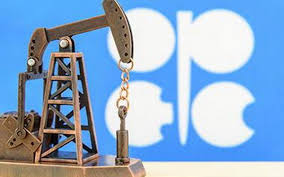After a month in which oil prices surged 15% and geopolitical tensions seethed around the world, OPEC and its allies took a record-quick 16 minutes to decide that they would stick to their previously planned output increase.
Apparently, there were no lengthy discussions at Wednesday’s meeting about member nations of the producer group failing to hit their production targets or about one of the busiest months on the geopolitical front in years, featuring: a potential war between Russia and Ukraine; rare unrest in Kazakhstan; hints of progress in nuclear talks progress between the United States and Iran; and repeated Houthi drone attacks on the United Arab Emirates.
They instead chose to complete their regular monthly meeting in record time, avoiding any thorny discussions. OPEC+, which groups the Organization of the Petroleum Exporting Countries and its allies led by Russia, agreed to a small increase for March, raising the collective oil production target by 400,000 barrels per day (bpd).
Brent crude prices hit a seven-year high of $91.70 a barrel on Jan 28 and are currently trading at about $90.
Several OPEC+ delegates said the latest leg of oil’s rally was a result of concern over the potential for supply disruption due to conflict rather than an issue with undersupply.
“Prices are high not because of market fundamentals but because of geopolitics,” one delegate said.
The source said, however, that geopolitical tensions were not discussed. “Nothing political (was) raised,” he said.
The group has been making the same monthly adjustment to targets since August as it slowly unwinds record cuts made at the height of the pandemic, when fuel demand slumped worldwide.
OPEC+ has fallen well short of meeting the rising target, and is trailing the recovery in fuel demand, because several members failed to make needed investments to maintain oilfields during the pandemic.
As well as the international crisis over Ukraine, tension this month also arose on the Arabian Peninsula where Yemen’s Iran-aligned Houthis have launched drones and missiles to attack the United Arab Emirates in an escalation of a conflict with a military coalition led by Saudi Arabia.
“A geopolitical premium is baked into prices with the Russia-Ukraine standoff continuing and trigger-happy Houthi rebels in Yemen,” PVM analyst Stephen Brennock said.
Asked about the main driver behind the decision, another OPEC+ delegate said, “This decision … suits everyone, both those who have the capacity to increase their supply and those who cannot”.
“With this decision, we maintain the cohesion of the group and we leave the difficult discussions for later,” he added, referring to dwindling capacity among some members.
OPEC+ data shows that in 2021 the group produced on average over 800,000 bpd below its production targets as some – mainly Western African – producers struggled with underinvestment.
The group’s lack of spare capacity — idled oilfields ready to come online quickly to deal with unexpected outages in global supply — along with a post-pandemic demand recovery, has put a charge into energy prices and driven global inflation higher.
Just a few producers hold most of that global spare capacity: Saudi Arabia, the United Arab Emirates and Iraq.
Several analysts, including Goldman Sachs, argue that the very thin spare capacity could push oil prices over the $100 mark later this year.
US sanctions are also keeping millions of barrels of production offline in Iran and Venezuela.
The quick decision gives the group more time to wait for the direction of the Iran nuclear talks with the West which would pave the way for the lifting sanctions on oil exports from the OPEC member.
Indirect talks between the United States and Iran are entering the “final stretch,” with all sides having to make tough political decisions, a senior US State Department official said this week.
Meanwhile Iranian oil minister Javad Owji was quoted as saying Tehran was ready to return to the oil market quickly, which could boost supply by an additional 1.5 million bpd.
This month, China’s customs reported the first import of Iranian crude in a year despite ongoing sanctions, offloading nearly 4 million barrels of Iranian crude oil into state reserve tanks.
“The White House has already seemingly dispensed with the maximum pressure sanctions enforcement policy, and more Iranian (and Venezuelan) barrels are making their way to China,” RBC Capital’s Helima Croft said.
Any nuclear deal with Iran will most likely force OPEC+ to rearrange its production quotas to make room for Iranian barrels as in previous years.
Extra Iranian supply, however, could help plug the hole in OPEC+’s output target misses, one of the sources said.

 Iran Energy News Oil, Gas, Petrochemical and Energy Field Specialized Channel
Iran Energy News Oil, Gas, Petrochemical and Energy Field Specialized Channel



